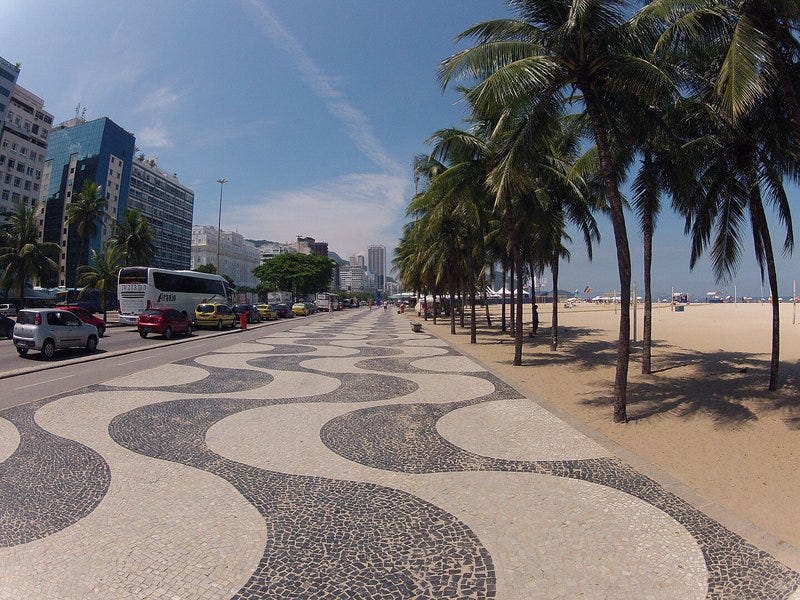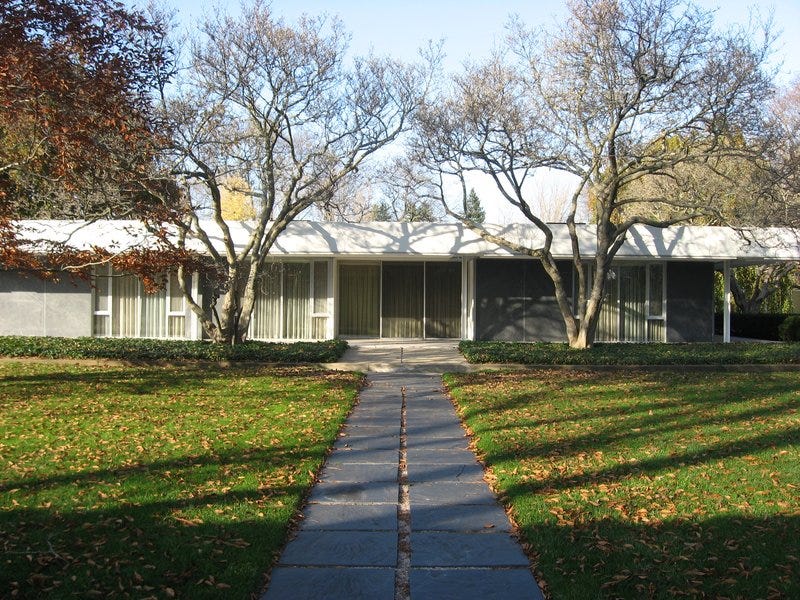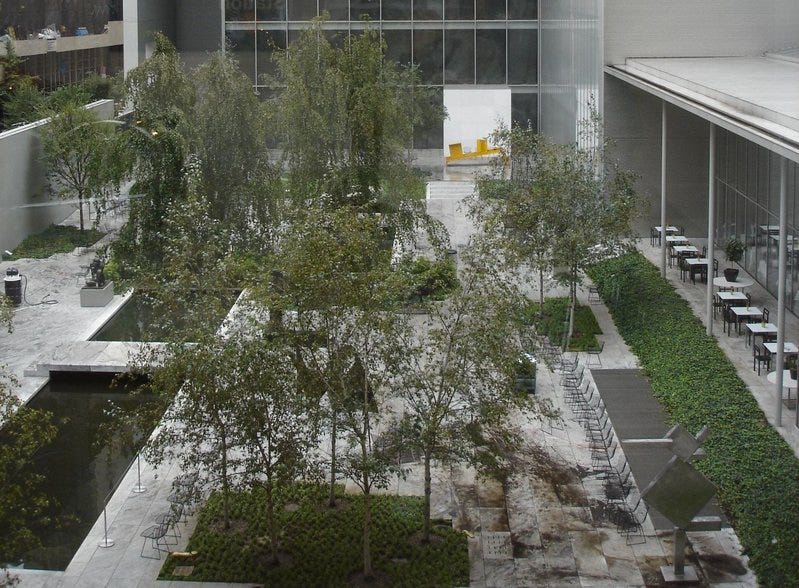Modernist Gardens
Modernist gardens offer a unique blend of simplicity, clarity, and thoughtful design that has reshaped the way we think about outdoor spaces.
Emerging in the early 20th century as an adjacent movement to modernist architecture and art, modernist gardens reflect a break from tradition and a celebration of new materials, forms, and ideas. At their heart lies a desire to connect people with nature through minimalist beauty, function, and harmony.
The Roots of Modernism in Garden Design
Modernism in landscape design developed in tandem with movements in art, architecture, and design that rejected excessive ornamentation and historical pastiche. Where previous garden styles quite often looked to the past, modernist gardens looked forward.
The philosophy for modernism is simple: design for modern life. This meant spaces that were practical, beautiful, and deeply integrated with contemporary architecture. Influenced by the Bauhaus, De Stijl, and the International Style, designers emphasized form following function, clean geometry, and honesty in materials.
Key Principles of Modernist Gardens
Minimalism and Clarity
Modernist gardens are known for their minimalism. This doesn't mean barren spaces, but rather the thoughtful elimination of excess. Every element serves a purpose, and the result is a serene, uncluttered environment that encourages reflection and connection.
Geometric Structure
Geometry plays a central role in modernist garden design. Rectangles, squares, and circles are used in paving, planting beds, water features, and lawn shapes. These clean lines create order and contrast with the organic forms of plants.
Integration with Architecture
One of the defining features of modernist gardens is their relationship to architecture. They are designed as extensions of the home, using similar materials and aligning sightlines, thresholds, and forms. Floor-to-ceiling windows, patios, and open-plan layouts allow for seamless indoor-outdoor living.
New Materials
Modernist gardens embrace industrial and modern materials like poured concrete, steel, glass, and smooth stone. These materials are often left exposed to celebrate their textures and structural honesty. Timber, gravel, and metals like cor-ten steel also feature prominently.
Asymmetry and Spatial Flow
Unlike traditional formal gardens that rely on symmetry, modernist gardens often use asymmetrical balance. This creates dynamic, flowing spaces that feel open and responsive to human movement and natural growth patterns.
Sculptural Planting
Planting in modernist gardens is intentional and often sculptural. Plants are chosen for their form, texture, and seasonal interest rather than just for flower color. Repetition of species and careful placement enhance rhythm and unity.
Notable Figures in Modernist Garden Design
Thomas Church
An influential American landscape architect, Church is often credited with bringing modernist principles to residential gardens. His work in California embraced outdoor living, functional beauty, and curvilinear forms, as seen in the iconic Donnell Garden (1948), with its famous kidney-shaped pool.
Roberto Burle Marx
A Brazilian visionary, Burle Marx revolutionized tropical landscape design. He treated gardens as living paintings, using bold sweeps of color, native plants, and modern abstraction. His work includes the famous Copacabana Beach promenade in Rio de Janeiro.
Dan Kiley
Kiley was a master of combining geometry with natural beauty. His design for the Miller House Garden in Indiana is a quintessential example of modernist landscape architecture, featuring a grid of trees, modern sculptures, and clean outdoor rooms.
Garrett Eckbo and James Rose
These American designers pushed the boundaries of landscape design in the mid-20th century. They emphasized social functionality, community spaces, and innovative planting combinations, contributing to the modernist dialogue with fresh perspectives.
Examples of Modernist Gardens and Landscapes
Miller House Garden, Indiana, USA (Dan Kiley)
Copacabana Beach promenade, Rio de Janeiro (Burle Marx)

Donnell Garden, Sonoma, California (Thomas Church)

MoMA Sculpture Garden, New York (Philip Johnson and James Fanning)
Design Elements and Features
Hard Landscaping
Paths, patios, and walls in modernist gardens are simple, linear, and functional. Concrete, steel, and stone are favored, often in large slabs or modular formats. Raised planters, cantilevered benches, and retaining walls are used to define space and add height.
Water Features
Water is used sparingly but effectively—still reflecting pools, sleek , or geometric fountains. These elements add movement, sound, and tranquility without overpowering the garden.
Outdoor Living Spaces
Modernist gardens are meant to be lived in. Decks, terraces, and seating areas are designed for comfort and utility. Furniture is often modern in style: low, modular, and weather-resistant.
Lighting and Art
Subtle, integrated lighting enhances the garden's mood and usability at night. Modern sculptures or installations provide visual interest and act as focal points. Abstract forms and materials echo the architectural language of the house.
Planting in a Modernist Garden
Plant selection is crucial. Rather than a wide variety of species, designers often use fewer types but plant them in bold, rhythmic groupings. Plants with architectural shapes like agaves, grasses, or clipped shrubs are favored.
Native and drought-tolerant plants are popular, especially in climates where water conservation is key. Evergreens ensure year-round structure, while perennials offer seasonal variation. Vertical interest may come from multi-stemmed trees, such as birch or olive.
Color palettes tend to be muted: silvers, greens, purples, and whites dominate, with occasional bright accents. Texture and form take precedence over floral abundance.
Modernist Gardens Today
Modernist garden principles continue to influence contemporary design. In urban environments, where space is limited, the clarity and efficiency of modernist layouts are especially valuable. Designers today adapt these ideas with ecological awareness, incorporating native planting, rain gardens, and sustainable materials.
In places like California, Australia, and southern Europe, the modernist garden remains a practical and stylish choice. Meanwhile, minimalist courtyards in cities like Tokyo or Copenhagen show how the essence of modernism can be scaled down to even the smallest outdoor spaces.
Why Choose a Modernist Garden?
A modernist garden is ideal for those who appreciate clean design, structured planting, and harmony with modern architecture. It offers a calm, meditative outdoor space with high functionality and low maintenance.
Whether it's a private courtyard or a public park, the principles of modernist garden design remain timeless: simplicity, elegance, and connection to place.
Creating Your Own Modernist Garden: Tips to Get Started
Think in clean lines: use rectangles or swooping curves to define paths and beds.
Limit your plant palette: choose structural, low-maintenance species.
Use modern materials: concrete, cor-ten steel, smooth stone, and hardwood.
Keep furniture simple and modern.
Connect indoors and out: align views, doors, and windows with garden elements.
Add focal points: a sculpture, water feature, or tree with striking form.
Light it thoughtfully: use hidden or low-profile fixtures to enhance atmosphere.
By embracing these ideas, you can create a garden that feels modern, timeless, and deeply personal—a quiet space where design and nature meet in perfect balance.



